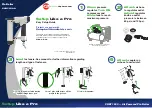
8
damage, distortion, displacement.
• Special fields of application for the
tool may require the observance of
additional provisions and regula-
tions (for example working in areas
subject to an explosion hazard).
• Do not carry out any alterations to
the tool without the manufacturer’s
authorisation;
• Do not disassemble or make inop-
erative any parts of the tool such
as the safety yoke;
• Do not perform any ”emergency
repairs” without proper tools and
equipment;
• The tool should be serviced
properly and at regular intervals in
accordance with the manufactur-
er’s instructions;
• Avoid weakening or damaging the
tool, for example by:
• punching or engraving;
• modification not authorised by the
manufacturer;
• guiding against templates made of
hard material such as steel;
• dropping or pushing across the
floor;
• use the equipment as a hammer;
applying excessive force of any
kind.
LOADING
Disconnect the tool from air supply.
(
Figure 3
)
Release magazine by pushing click
lever. (
Figure 4
)
Loading pins: hold the nail gun
downwards and load a strip of nails
into the cartridge, with the points
facing downwards. (
Figure 5
)
Then shut the magazine by pushing
it fully upwards. Use only recom-
mended fasteners (see technical
specifications). (
Figure 6
)
The tool and the fasteners specified
in the operating instructions are to
be considered as one unit safety
system.”
TOOL USE
• Keep tool pointed away from your-
self and others and connect tool
to air supply.
• Tools shall be operated at the
lowest pressure needed for the
application. This will reduce noise
levels, part wear and energy use.
• Press the nose of the tool onto
the workpiece to be fastened and
press the trigger to fire staples.
Adjust the mini pressure which is
necessary for the penetration of
the fasteners. Then, make some
tests in starting with the lowest
pressure. (
Figure 7
)
• Check whether the fastener has
been driven into the workpiece in
accordance with the requirements.
- if the fastener is protruding, in-
crease the air pressure in incre-
ments of 0,5 bar, checking the
result after each new adjustment;
- if the fastener is driven into an
excessive depth, reduce the air
pressure in increments of 0,5 bar
until the result is satisfactory.
You should endeavour in any event
to work with the lowest possible air
pressure.
Hold the tool during the work oper-
ation in such a way that no injuries
can be caused to the head or to the
body in the event of a possible recoil
consequent upon a disruption in the
energy supply or hard areas within
the workpiece.
Summary of Contents for PMP171
Page 2: ...2...
Page 4: ...4...
Page 53: ...53 ISO8662 11 1999 uncertainty u 0 332 m s2 2 24m s2 c 10...
Page 54: ...54 Figure 1 Figure 3 Figure 2 a Figure 3...
Page 55: ...55 Figure 4 Figure 5 Figure 6 Figure 7 10 Figure 11 10...
Page 80: ...80 10 Figure 1 Figure 3 Figure 2...
Page 81: ...81 Figure 3 Figure 4 Figure 5 Figure 6 Figure 7 Figure 3 Figure 8 Figure 9 Figure 10 2 3...
Page 95: ...95 10 Figure 1 Figure 3 p Figure 2...
Page 96: ...96 Figure 3 Figure 4 Figure 5 Figure 6 Figure 7 Figure 3 Figure 8 Figure 9 Figure 10 2 3...
Page 97: ...97 KiTno Description KitArtno KitA 5001346 KitB 5001347 KitC 5001348 Figure 12...
Page 98: ...98...
Page 99: ...99...









































